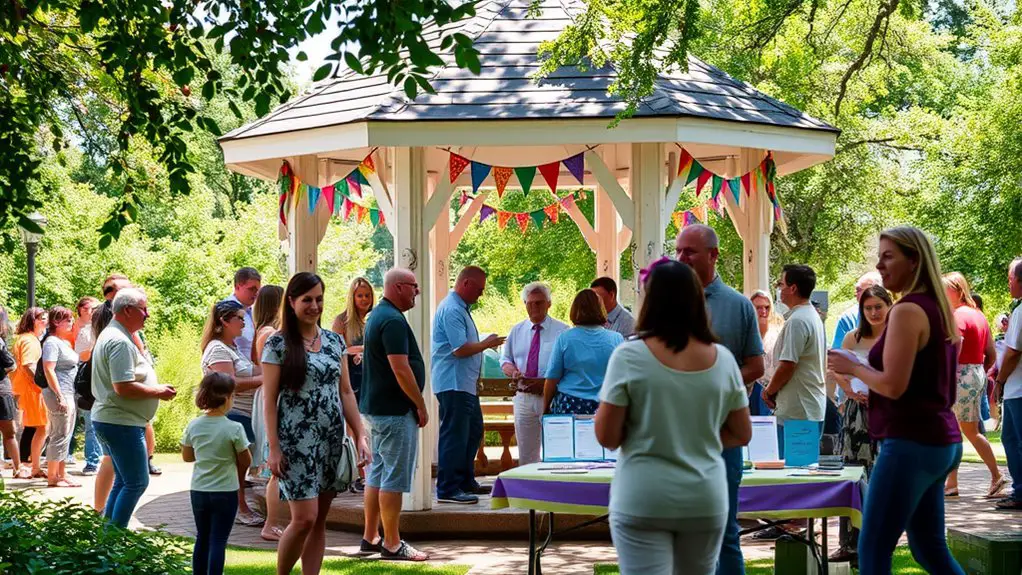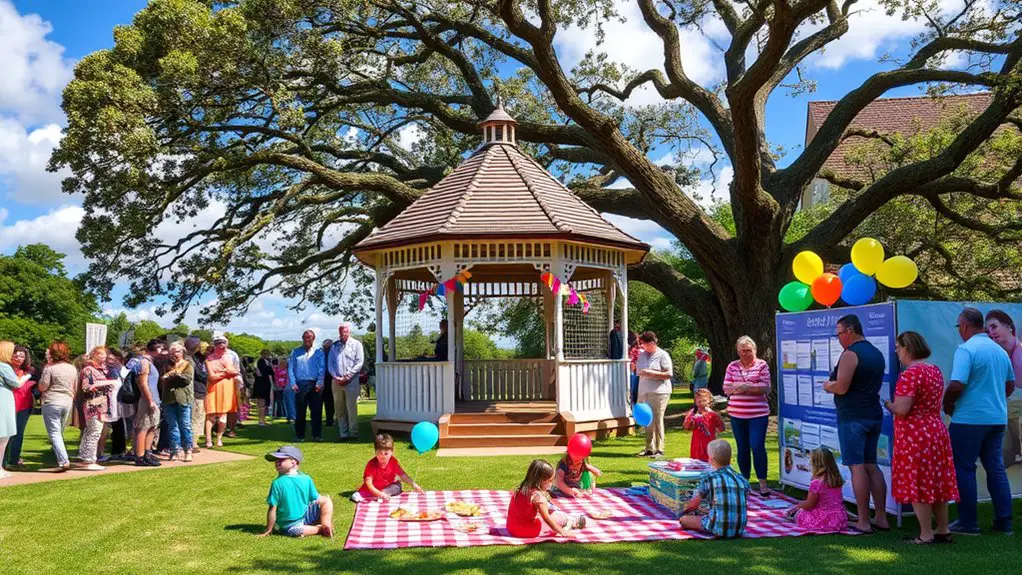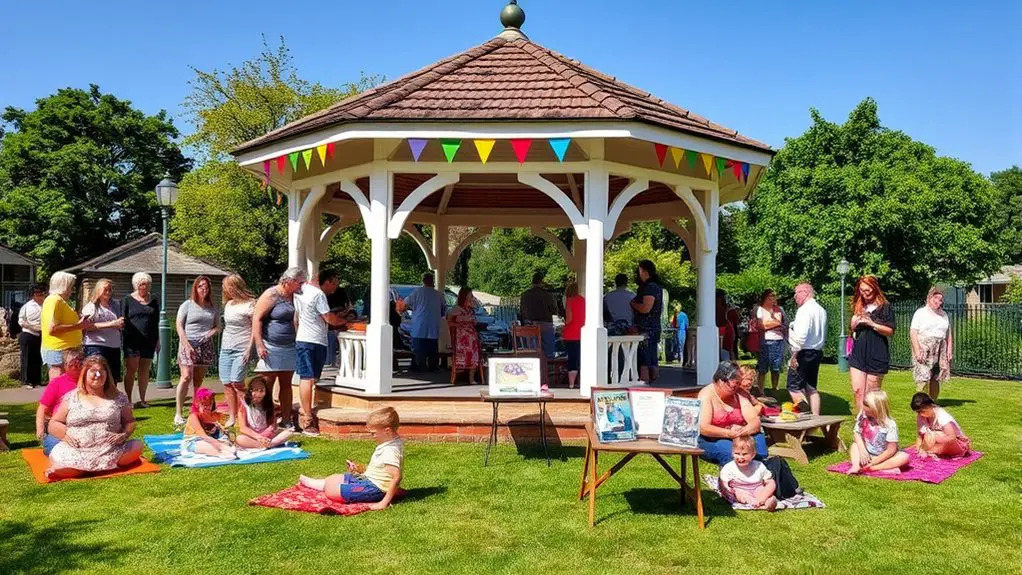To organize a community event around a gazebo, start by defining your event’s purpose and goals. Choose a date that avoids conflicts and suits local schedules. Secure any necessary permits and permissions early on. Plan engaging activities like workshops and live music, and promote the event through social media and local channels. Coordinate logistics, including seating and sound systems. Don’t forget to prepare for weather changes. For more insights, keep exploring the essential steps to guarantee your event’s success.
Identify the Purpose of Your Event

Before diving into the logistics of organizing a community event, it’s crucial to identify its purpose, as this foundation will guide every decision you make. Start by clarifying your event goals. Are you looking to foster community connections, raise funds, or celebrate a local tradition? Defining these objectives helps shape the event’s structure and activities.
Next, consider the community needs. What issues or interests resonate within your area? Engaging with local residents through surveys or informal conversations can provide invaluable insights. This guarantees your event not only attracts attendees but also addresses their desires and concerns.
Once you’ve established clear goals and identified community needs, you’ll have a strong framework for planning. This clarity allows you to choose relevant themes, activities, and marketing strategies that resonate with your audience, ultimately leading to a more impactful event that fosters the freedom and connection your community craves.
Choose the Right Date and Time
When you’re choosing a date and time for your event, it’s essential to check local calendars for any conflicting events. You should also assess the weather conditions to guarantee a comfortable experience for attendees. Finally, think about when your community is most available to maximize participation.
Consider Local Calendars
How can you guarantee your community event attracts the right audience? Start by checking local calendars. These calendars often list competing local events, so you can choose a date and time that doesn’t overlap with other gatherings. Avoid weekends packed with festivals, sports events, or holidays, as they might draw potential attendees away. Consider the demographic of your audience too; if your event caters to families, scheduling it on a Saturday afternoon might work well. Conversely, if you’re aiming at young adults, a Friday evening could be ideal. By being mindful of existing local events, you’ll enhance your chances of a successful turnout and create a vibrant community atmosphere around your gazebo.
Assess Weather Conditions
Choosing the right date and time for your community event also means taking weather conditions into account. Start by checking weather forecasting services to get an accurate prediction for your chosen date. Look at seasonal trends in your area—this can help you avoid unexpected rain or chilly temperatures. For example, late spring or early fall often offers milder weather, making it ideal for outdoor gatherings. Consider local climate patterns and historical data to further guide your decision. If you’re planning an event during a potentially volatile season, have a backup plan in place, like an alternative indoor venue. This way, you’ll guarantee everyone can enjoy the event, regardless of what Mother Nature has in store.
Target Community Availability
Have you considered the availability of your community when planning your event? Selecting the right date and time is essential for maximizing attendance. Start by analyzing your community demographics—understanding who lives there can help you choose a time that works best for everyone. Conduct availability surveys to gather insights on when the majority are free. Consider local holidays, school schedules, and typical work hours. Weekends or early evenings often attract larger crowds, but always check your survey results for specific preferences. You want your event to be accessible and enjoyable, allowing for a sense of freedom and connection among attendees. Prioritizing community availability not only fosters attendance but also strengthens local bonds.
Secure Necessary Permits and Permissions
Before your community event can take place, you’ll need to secure the necessary permits and permissions. Start by researching local regulations to understand what’s required, then contact the relevant authorities for guidance. Finally, make sure to submit your permit application well in advance to avoid any last-minute issues.
Research Local Regulations
Although planning a community event can be exciting, it’s essential to navigate the maze of local regulations to assure everything runs smoothly. Start by researching local zoning laws that might affect your event. Different zones can have specific event restrictions, so you’ll want to make certain your plan aligns with these guidelines. Check for any noise ordinances, capacity limits, or restrictions on types of activities allowed in public spaces. Understanding these regulations helps you avoid potential fines or disruptions. Additionally, familiarize yourself with any permit requirements. By taking the time to understand your community’s regulations, you empower yourself to create an event that respects local guidelines while fostering a vibrant atmosphere for everyone.
Contact Relevant Authorities
Once you’ve familiarized yourself with local regulations, it’s time to contact the relevant authorities to obtain the necessary permits and permissions for your event. This step is essential to guarantee you’re compliant with authority guidelines and can host a successful gathering.
Here are some tips to facilitate this process:
- Identify your community liaison: Reach out to someone familiar with local protocols.
- Gather required information: Have details about your event ready, like date, time, and location.
- Be clear about your needs: Explain the type of permits you need and any specific requirements.
- Stay organized: Keep track of deadlines and follow up as necessary.
This proactive approach will pave the way for a seamless event!
Submit Permit Application
With the necessary information at hand, you can now focus on submitting your permit applications. Start by determining the permit types required for your event, which might include special use permits, noise permits, or even food vendor permits. Each type has its own application process, so be certain to review the specific requirements for each. Gather all necessary documents, such as proof of insurance, site plans, and event details. Fill out the applications accurately, making sure that you meet deadlines to avoid delays. Don’t hesitate to reach out to local authorities for guidance—they can clarify any uncertainties. Once submitted, monitor your application status and be prepared for possible follow-up questions. This proactive approach will help guarantee your event goes off without a hitch.
Plan the Event Activities
When you’re planning the event activities, it’s essential to take into account your audience’s interests and needs to guarantee engagement and enjoyment. Start with some activity brainstorming to gather ideas that resonate. Think about incorporating interactive workshops that allow participants to engage in hands-on experiences. Here are some activities to think about:
- Live music performances: Local bands can create a lively atmosphere.
- Art and craft stations: Encourage creativity with DIY projects for all ages.
- Cooking demonstrations: Invite local chefs to share their culinary skills.
- Community games and contests: Foster a sense of camaraderie with fun competitions.
Additionally, consider utilizing the gazebo’s aesthetic appeal to enhance the overall ambiance of your event, making it a more inviting space for attendees.
Promote Your Event

To successfully draw attention to your community event, it’s essential to utilize a variety of promotional strategies that effectively reach your target audience. Start by leveraging social media platforms like Facebook, Instagram, and Twitter. Create engaging posts that include eye-catching images of the gazebo and highlight key event details. Use relevant hashtags to increase visibility.
Next, consider community outreach. Partner with local businesses and organizations to spread the word. They can help promote your event through their own channels, creating a broader reach. Don’t forget to design flyers and distribute them in high-traffic areas, like libraries and coffee shops, where community members gather.
Lastly, encourage word-of-mouth promotion. Ask friends, family, and volunteers to share information about the event within their networks. By combining these strategies, you’ll create a buzz that draws attendees to enjoy the festivities around your gazebo!
Coordinate Logistics and Setup
As you plunge into coordinating logistics and setup for your community event, it’s important to create a detailed plan that addresses all necessary elements. Start with a clear setup timeline to guarantee everything runs smoothly. This will help you keep track of when to set up tables, chairs, and other equipment.
Consider putting together an equipment checklist to avoid any last-minute surprises. Here are some key items to include:
- Seating arrangements for attendees
- Sound system and microphones for announcements
- Decorations to enhance the gazebo’s appeal
- Trash and recycling bins to maintain cleanliness
Communicate roles and responsibilities with your volunteers, so everyone knows what to do on the day of the event. By staying organized and proactive, you’ll create an enjoyable atmosphere that encourages community bonding. Additionally, ensure to have a plan for installing mosquito netting to keep attendees comfortable and bug-free during the event.
Engage Local Vendors and Sponsors

Once the logistics and setup are in place, engaging local vendors and sponsors can greatly enhance the experience of your community event. By forming vendor partnerships, you not only support local businesses but also offer unique products and services to attendees. Consider creating sponsorship opportunities that benefit both parties, adding value to your event.
| Vendor Type | Partnership Benefits | Sponsorship Opportunities |
|---|---|---|
| Food Trucks | Attract food lovers | Logo on promotional materials |
| Artisans | Showcase local talent | Booth space for visibility |
| Local Musicians | Create a lively atmosphere | Performance sponsorship |
Reach out to potential vendors early, discussing how their involvement can enrich the event and emphasize community spirit. This collaboration can lead to a vibrant, engaging atmosphere, making your event a memorable experience for everyone involved.
Prepare for Weather Contingencies
While you can’t control the weather, preparing for contingencies can guarantee your community event runs smoothly regardless of unexpected changes. Start by thinking ahead about potential rain and other weather scenarios. Here are some practical steps to reflect on:
Preparing for weather contingencies ensures your community event remains enjoyable, even when unexpected changes arise.
- Develop rain contingency plans: Outline what you’ll do if it rains, such as rescheduling or moving activities under cover.
- Identify alternative venue options: Look for nearby indoor locations that can accommodate your event if the weather turns severe.
- Communicate with attendees: Keep everyone informed about weather updates and any changes to the event schedule via social media or email.
- Have supplies ready: Stock up on umbrellas, ponchos, or even tents to help keep everyone comfortable, should unexpected weather arise.
Gather Feedback and Evaluate the Event
How can you truly measure the success of your community event? Gathering feedback is essential to understanding its impact and areas for improvement. Start by creating a feedback survey that’s easy for attendees to complete. Consider including questions about their overall experience, event organization, and suggestions for future gatherings.
Distributing the survey immediately after the event, whether digitally or on paper, guarantees that participants’ thoughts are fresh. Encourage honest responses by emphasizing that their input is invaluable in shaping future events.
Once you’ve collected the data, conduct a thorough event evaluation. Analyze the feedback to identify trends and common themes—this will guide your planning for future events.
Frequently Asked Questions
How Can I Ensure Accessibility for All Attendees?
Think of accessibility as a bridge, connecting everyone. Make certain wheelchair access is clear, and consider sensory needs, like quiet areas. This way, you’ll create an inclusive space where all attendees can truly enjoy the event.
What Should I Do if the Gazebo Is Already Booked?
If the gazebo’s booked, consider alternative venues nearby that suit your event’s vibe. You could also explore rescheduling options to secure the gazebo later. Flexibility can lead to a successful community gathering, no matter the location.
How Can I Involve Local Schools or Community Groups?
Think of your event as a garden; by cultivating school partnerships and nurturing community outreach, you’ll create a vibrant space for collaboration. Invite local schools to showcase talents, and community groups to provide resources.
What Safety Measures Should I Consider for the Event?
When planning your event, guarantee you have clear emergency procedures in place and effective crowd management strategies. This’ll help everyone feel safe and free to enjoy the festivities without unnecessary worries or disruptions.
How Do I Handle Conflicts With Neighbors or Local Residents?
When conflicts arise, prioritize neighbor communication. Listen to concerns, address issues calmly, and propose solutions. Use conflict resolution strategies to maintain harmony, ensuring everyone feels heard and valued. This fosters a sense of community and freedom for all.

